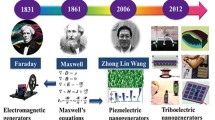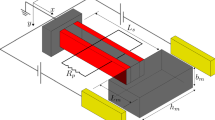Abstract
Small scale electrostatic energy harvesters or microgenerators have attracted much interest due to their compatibility with micro-electro-mechanical-system (MEMS) fabrication processes and the possibility to energize wireless sensors and actuators through harvesting movement or vibration from surrounding environment. Several analytical models have been developed to estimate the performance of electret-based microgenerators. However, most of these studies focused on constant-speed rotations, while in practice, mechanical stimuli resemble sinusoidal vibrations. Consequently, a combination of finite element modeling and numerical methods has been the primary approach to analyze and optimize the performance of electret-based microgenerators. Both approaches are time-consuming, costly and more importantly, limit the understanding of design trade-offs involved. In this paper, we present an analytical model that accurately predicts the output voltage and effective power generated by electret-based microgenerators under small sinusoidal excitations. The developed model is validated using numerical simulations that show a good agreement with measured results published in the literature. We also employ the analytical model to optimize the microgenerator by investigating the effects of electret thickness, air gap spacing between the two plates of the microgenerator, and electret surface potential with respect to material properties.













Similar content being viewed by others
References
Asanuma H, Oguchi H, Hara M, Yoshida R, Kuwano H (2013) Ferroelectric dipole electrets for output power enhancement in electrostatic vibration energy harvesters. Appl Phys Lett 103(16):162901
Bartsch U, Sander C, Blattmann M, Gaspar J, Paul O (2009) Influence of parasitic capacitances on the power output of electret-based energy harvesting generators. In: Proc. PowerMEMS, pp 332–335
Boisseau S, Despesse G, Ricart T, Defay E, Sylvestre A (2011) Cantilever-based electret energy harvesters. Smart Mater Struct 20(10):105013
Boisseau S, Despesse G, Sylvestre A (2010) Optimization of an electret-based energy harvester. Smart Mater Struct 19(7):075015
Boland J, Chao Y-H, Suzuki Y, Tai YC (2003) Micro electret power generator. In: Proc. MEMS, pp 538–541
Chen R, Suzuki Y (2013) Suspended electrodes for reducing parasitic capacitance in electret energy harvesters. J Micromech Microeng 23(12):125015
Franco S (2002) Design with operational amplifiers and analog integrated circuits, 3rd edn, chapter 4. McGraw-Hill, pp 187–188
Genter S, Paul O (2012) Parylene-C as an electret material for micro energy harvesting. In: Proc. PowerMEMS, pp 317–320
Gradshteyn IS, Ryzhik IM (2014) Table of integrals, series, and products, chapter 3. Academic press, p 318
Graham JB, DeWar H, Lai N, Lowell WR, Arce SM (1990) Aspects of shark swimming performance determined using a large water tunnel. J Exp Biol 151(1):175–192
Hirasaki E, Moore ST, Raphan T, Cohen B (1999) Effects of walking velocity on vertical head and body movements during locomotion. Exp Brain Res 127(2):117–130
Husain E, Nema RS (1982) Analysis of Paschen curves for air, N2 and SF6 using the Townsend breakdown equation. IEEE Trans Electr Insul EI-17(4):350–353
James E, Tudor M, Beeby S, Harris N, Glynne-Jones P, Ross J, White N (2004) An investigation of self-powered systems for condition monitoring applications. Sens Actuators A Phys 110(1):171–176
Jefimenko OD, Walker DK (1978) Electrostatic current generator having a disk electret as an active element. IEEE Trans Indus Appl 6:537–540
Masaki T, Sakurai K, Yokoyama T, Ikuta M, Sameshima H, Doi M, Seki T, Oba M (2011) Power output enhancement of a vibration-driven electret generator for wireless sensor applications. J Micromech Microeng 21(10):104004
Meninger S, Mur-Miranda JO, Amirtharajah R, Chandrakasan A, Lang JH (2001) Vibration-to-electric energy conversion. IEEE Trans Very Large Scale Integr (VLSI) Syst 9(1):64–76
Nakano J, Komori K, Hattori Y, Suzuki Y (2015) MEMS rotational electret energy harvester for human motion. In: Proc. PowerMEMS, p 012052
Naruse Y, Matsubara N, Mabuchi K, Izumi M, Suzuki S (2009) Electrostatic micro power generation from low-frequency vibration such as human motion. J Micromech Microeng 19(9):094002
Romero E, Warrington RO, Neuman MR (2009) Body motion for powering biomedical devices. In: Proc. EMBS, IEEE, pp 2752–2755
Roundy S, Wright PK (2004) A piezoelectric vibration based generator for wireless electronics. Smart Mater Struct 13(5):1131–1142
Roundy S, Wright PK, Rabaey J (2003) A study of low level vibrations as a power source for wireless sensor nodes. Comput Commun 26(11):1131–1144
Smith E (2013) Mechanical engineer’s reference book, chapter 7. Elsevier Science, p. 7/126
Sodano HA, Park G, Inman D (2004) Estimation of electric charge output for piezoelectric energy harvesting. Strain 40(2):49–58
Tada Y (1986) Theoretical characteristics of generalized electret generator, using polymer film electrets. IEEE Trans Electr Insul 3:457–464
Tada Y (1992) Experimental characteristics of electret generator, using polymer film electrets. Jpn J Appl Phys 31(3R):846
Tsutsumino T, Suzuki Y, Kasagi N, Kashiwagi K, Morizawa Y (2006) Micro seismic electret generator for energy harvesting. In: Proc. PowerMEMS, pp 279–282
Tsutsumino T, Suzuki Y, Kasagi N, Sakane Y (2006) Seismic power generator using high-performance polymer electret. In: Proc. MEMS, pp 98–101
Weisstein EW (2002) Hypergeometric function. From MathWorld—A Wolfram Web Resource
Williams C, Yates RB (1996) Analysis of a micro-electric generator for microsystems. Sens Actuators A Phys 52(1):8–11
Yen BC, Lang JH (2006) A variable-capacitance vibration-to-electric energy harvester. IEEE Trans Circuits Syst I Regular Papers 53(2):288–295
Zhou Y, Apo DJ, Priya S (2013) Dual-phase self-biased magnetoelectric energy harvester. Appl Phys Lett 103(19):192909
Acknowledgements
This work is supported by the Department of State Development: Collaboration Pathways Program-South Australia Government (CPP 39).
Author information
Authors and Affiliations
Corresponding author
Rights and permissions
About this article
Cite this article
Nguyen, C.C., Ranasinghe, D.C. & Al-Sarawi, S.F. Analytical modeling and optimization of electret-based microgenerators under sinusoidal excitations. Microsyst Technol 23, 5855–5865 (2017). https://doi.org/10.1007/s00542-017-3349-1
Received:
Accepted:
Published:
Issue Date:
DOI: https://doi.org/10.1007/s00542-017-3349-1




